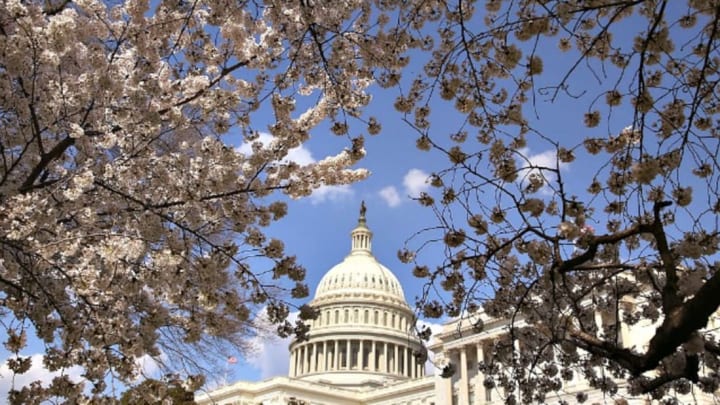The Women Who Chained Themselves to D.C.'s Cherry Trees

Among other things, Washington, D.C. is known for its thousands of beautiful cherry blossom trees, which flower spectacularly every March and April in an eye-popping explosion of blush-colored blooms. But on November 17, 1938, the gorgeous trees caused fireworks of a different sort.
The iconic trees have commanded attention for more than a century, with the first pair planted in 1912 by First Lady Helen Taft and the Viscountess Chinda, the wife of the Japanese Ambassador. A total of 3020 cherry trees of 12 varieties were eventually planted in the area, including East Potomac Park, the Washington Monument grounds, and the Tidal Basin. The trees grew and flourished for more than 20 years—and then the Thomas Jefferson Memorial Commission was formed, charged with planning the construction of the monument to our third president.
After much debate, the commission recommended that the Jefferson Memorial be erected on the Tidal Basin site where it stands today, which would require the removal of some of the cherry blossom trees. Washington society ladies, led by editor of the Washington Times-Herald Eleanor Patterson, immediately protested, horrified at the prospect of losing the natural splendor of the trees.
The media piled onto the problem, with one article estimating that nearly 600 trees would meet their untimely demises. President Franklin Roosevelt called the report "one of the most interesting cases of newspaper flimflam" he had ever come across. The trees, he promised, would be relocated—not chopped down.
Unconvinced by the president’s statement, 50 women marched on the White House on November 17, 1938, the day construction started, to deliver a petition to halt the wanton destruction of their beloved trees.
When that didn’t work, approximately 150 society ladies showed up to the construction site the next day, wearing furs and carrying chains. They snatched shovels from the workers’ hands, refilling freshly dug holes and even chaining themselves to the trees. They sang a version of Joyce Kilmer’s "Trees" poem and created their own chant: "Who is it wants these grand old trees displaced? Who is it wants our fair D.C. disgraced?"
"This is the worst desecration of beauty in the capital since the burning of the White House by the British," a woman chained to a tree declared.
Roosevelt remained unmoved by the protests: If the activists didn’t remove themselves, he said, "the cherry trees, the women and their chains would be gently but firmly transplanted in some other part of Potomac Park."
According to the National Parks Service, the women eventually left because they needed bathrooms; Roosevelt had the trees taken out in the middle of the night instead. The protesters may have lost the battle, but they would no doubt be pleased to know that the war eventually went their way—today, there are more than 3750 cherry trees in Washington.